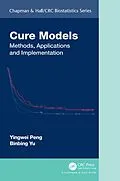Cure Models: Methods, Applications and Implementation is the first book in the last 25 years that provides a comprehensive and systematic introduction to the basics of modern cure models, including estimation, inference, and software. This book is useful for statistical researchers and graduate students, and practitioners in other disciplines to have a thorough review of modern cure model methodology and to seek appropriate cure models in applications. The prerequisites of this book include some basic knowledge of statistical modeling, survival models, and R and SAS for data analysis.
The book features real-world examples from clinical trials and population-based studies and a detailed introduction to R packages, SAS macros, and WinBUGS programs to fit some cure models. The main topics covered include
- the foundation of statistical estimation and inference of cure models for independent and right-censored survival data,
- cure modeling for multivariate, recurrent-event, and competing-risks survival data, and joint modeling with longitudinal data,
- statistical testing for the existence and difference of cure rates and sufficient follow-up,
- new developments in Bayesian cure models,
- applications of cure models in public health research and clinical trials.
Autorentext
Yingwei Peng is Professor of Biostatistics in the Departments of Public Health Sciences and Mathematics and Statistics at Queen's University and a senior Biostatistician at Queen's Cancer Research Institute. He has been an Associate Editor of Canadian Journal of Statistics since 2010 and provided referee services to all mainstream statistical journals and Canadian federal funding agencies (NSERC and CIHR). He offered short courses on cure models, either by himself or with Jeremy Taylor (University of Michigan, USA), in Joint Statistical Meetings, ENAR Spring Meeting, and Université catholique de Louvain, Belgium, in 2014. Binbing Yu is an Associate Director in the AstraZeneca oncology biometric group. He has extensive experience in the applications of cure models in public health, clinical trials and health economics and made notable contributions to the development and enhancement of cure modeling for the presentation and analysis of cancer survival data for the USA National Cancer Institute.
Klappentext
Cure Models: Methods, Applications and Implementation is the first book in the last 25 years that provides a comprehensive and systematic introduction to the basics of modern cure models, including estimation, inference, and software. This book is useful for statistical researchers and graduate students, and practitioners in other disciplines to have a thorough review of modern cure model methodology and to seek appropriate cure models in applications. The prerequisites of this book include some basic knowledge of statistical modeling, survival models, and R and SAS for data analysis.
The book features real-world examples from clinical trials and population-based studies and a detailed introduction to R packages, SAS macros, and WinBUGS programs to fit some cure models. The main topics covered include
- the foundation of statistical estimation and inference of cure models for independent and right-censored survival data,
- cure modeling for multivariate, recurrent-event, and competing-risks survival data, and joint modeling with longitudinal data,
- statistical testing for the existence and difference of cure rates and sufficient follow-up,
- new developments in Bayesian cure models,
- applications of cure models in public health research and clinical trials.
Inhalt
1. Introduction
A Brief Review of Cure Models
Time-to-Event Data and Cured Subjects
Survival Models and Cured Models
Aim and Scope of the Book
2. The Parametric Cure Model
Introduction
Parametric Mixture Cure Models
Parametric Incidence Submodel
Parametric Latency Submodel
Parametric PH Latency Submodel
Parametric AFT Latency Submodel
Other Parametric Latency Submodels
Model Estimation
Direct Maximization of Observed Likelihood Function
Estimation via EM Algorithm
Non-Mixture Cure Models
Proportional Hazards Cure Model
Cure Models Based on Tumor Activation Scheme
Cure Models Based on Frailty Models
Cure Models Based on Box-Cox Transformation
Model Assessment
Choosing an Appropriate Parametric Distribution
Mixture vs Non-Mixture Cure Models
Goodness of Fit by Residuals
Software and Applications
R Package gfcure
R Package mixcure
R Package _exsurvcure
SAS Macro PSPMCM
Summary
3. The Semiparametric and Nonparametric Cure Models
Introduction
Semiparametric Mixture Cure Models
Semiparametric PH Latency Submodel
Restrictions on the Upper Tail of the Baseline Distribution
Time-Dependent Covariates in the Latency Submodel
Semiparametric AFT Latency Submodel
Linear Rank Method
M-Estimation Method
Kernel Smoothing Method
Semiparametric AH Latency Submodel
Linear Rank Method
Kernel Smoothing Method
Semiparametric Transformation Latency Submodels
Semiparametric Incidence Submodel
Semiparametric Spline-Based Cure Models
Nonparametric Mixture Cure Models
Nonparametric Incidence Submodels
Kaplan-Meier Estimator
Generalized Kaplan-Meier Estimator
Nonparametric Latency Submodels
Semiparametric Non-Mixture Cure Models
Semiparametric PHC Model
General Non-Mixture Cure Models
Model Assessment
Residuals for Overall Model Fitting
Residuals for Latency Submodels
Assessing Cure Rate Prediction
Concordance Measures for Cure Models
Testing Goodness-of-Fit of Parametric Cure Rate Estimation
Variable Selection
Software and Applications
R Package mixcure
R Package smcure
SAS Macro PSPMCM
R Package Survival
R Package npcure
Summary
4. Cure Models for Multivariate Survival Data and Competing Risks
Introduction
Marginal Cure Models
Marginal Models with Working Independence
Marginal Models with Speci_ed Correlation Structures
Cure Models with Random E_ects
Mixture Cure Models with Frailties
Non-Nixture Cure Model with Frailties
Cure Models for Recurrent Event Data
Cure Models for Competing-Risks Survival Data
Classical Approach
Vertical Approach
Software and Applications
R Package geecure
R Package intcure
Summary
5. Joint Modeling of Longitudinal and Survival Data with a Cure Fraction
Introduction
Longitudinal and Survival Data with a Cured Fraction
Joint Modeling Longitudinal and Survival Data with Shared Random Effects
Modeling Longitudinal Proportional Data in Joint Modeling
Joint Modeling by Including Longitudinal Effects in Cure Model
Applications
Summary
6. Testing the Existence of Cured Subjects and Sufficient Follow-up
Introduction
Tests for Existence of Cured Subjects
Without Covariates
Likelihood Ratio Test
Score Test
With Covariates
Testing for Sufficient Follow-up
Summary…
